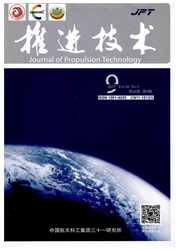

 中文摘要:
中文摘要:
为明晰氢燃料燃烧加热风洞中的水蒸气相变效应,采用同时考虑凝结和蒸发相变模型的多组分输运可压缩流动数值模拟方法,研究了超声速喷管内的水蒸气凝结过程以及凝结气流再蒸发对典型压缩构型(二维斜劈、三维斜劈和圆锥)流场参数及气动力的影响。结果表明:氢燃料燃烧加热风洞喷管气流中,水蒸气在较低总温条件下确实存在较大程度的凝结相变,但同时在斜劈激波压缩后也存在较强的蒸发相变;凝结会使喷管流场参数发生较大偏离,但再蒸发效应又会使气流经过斜劈压缩后趋近理想状态,趋近的程度受到压缩程度的影响。本文计算条件下,喷管内水蒸气相变导致出口参数偏差大于10%,但经过12°斜劈压缩后,流场参数以及表面气动力可恢复到理想状态的95%以上,此时相变的影响基本可以忽略。
 英文摘要:
英文摘要:
In order to understand water vapor phase transition effects in a hydrogen-fueled combustion- heated wind tunnel, a compressible multi-components fluid dynamics solver, in which both condensation and evaporation phase transition models are incorporated, is adopted to investigate water vapor condensation in hy- personic nozzle flows and the effects of condensed water evaporation on flow parameters as well as aerodynamic forces of typical supersonic compressible configurations (two-dimensional wedge, three-dimensional wedge and cone) . The results show that in nozzle flows of hydrogen-fueled combustion-heated wind tunnel, the water vapor will experience more condensation under the condition of relatively low total temperature, while the con- densed water will experience evaporation when passed through shock wave generated by compressible configura- tions. Water vapor condensation makes the flow parameters of nozzle outlet deviated from ideal state, while con- densed water evaporation makes the parameters recovered to ideal state. The degree of recovering is determined by the strength of the shock wave. In context of this investigation, the deviation of nozzle outlet parameters by condensation is somehow above 10%, while the flow parameters as well as aerodynamic forces can be recovered to above 95% of ideal state after a shock compression generated by a 12°wedge configuration. Under such condi-tions, the effects of water vapor phase transition can be neglected.
 同期刊论文项目
同期刊论文项目
 同项目期刊论文
同项目期刊论文
 期刊信息
期刊信息
